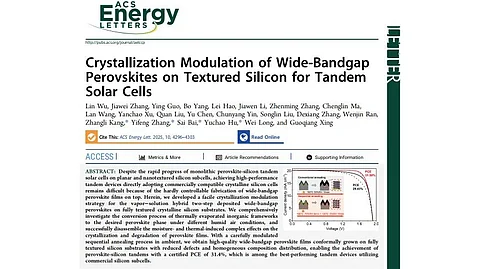

Leading solar manufacturer Tongwei has announced that its perovskite R&D team has published new research in the academic journal ACS Energy Letters, titled Crystallization Modulation of Wide-Bandgap Perovskites on Textured Silicon for Tandem Solar Cells. The study examines the crystallization control mechanism of wide-bandgap perovskites on textured silicon substrates and proposes a method to improve tandem solar cell performance.
According to the study, the researchers refined the 2-step evaporation – solution perovskite crystallization and film-forming approach – offering a simple and effective strategy to address the challenge of uniform film deposition for fully textured tandem cells. Tongwei said that it successfully fabricated compositionally uniform, defect-reduced perovskite films on fully textured commercial silicon substrates using mass-producible processes and equipment. The resulting cells achieved a 31.58% conversion efficiency (31.4% certified), which is a new record for tandem cells based on commercial silicon, according to the company.
Last month, Tongwei's Global Innovation R&D Center has announced that its latest TOPCon solar cell has achieved a bifaciality of 94.3%, certified by TÜV Rheinland (see China Solar PV News Snippets).
Perovskite manufacturer Shanghai Xuli Perovskite New Energy Co., Ltd. (Perovskite Energy), together with Fudan University, Shanghai Jiao Tong University, and the Yangtze River Delta Solar PV Technology Innovation Center, has secured a winning bid for a project titled Key Technology Research on Lightweight Perovskite/Crystalline Silicon Tandem Solar Modules for Satellites. The initiative is part of the 2025 Technical Standards program under the Key Technology R&D Plan led by the Shanghai Science and Technology Commission.
The project will focus on high-efficiency, stable perovskite top cells and ultra-thin, high-efficiency crystalline silicon solar cells, while further exploring material and structural optimization of tandem cell layers, metallization, and advanced encapsulation technologies. The goal is to establish a MW-scale demonstration line for lightweight perovskite/crystalline silicon tandem modules for application in satellites.
Integrated solar manufacturer Astronergy has announced that it has completed the supply of solar modules for a large-scale fishery-PV hybrid project in Jianhu County, Yancheng City, Jiangsu Province. The project, with a total capacity of 555 MW AC, combines aquaculture with solar power generation. Astronergy supplied ASTRO N5 bifacial dual-glass modules for the 242 MW AC Phase I of the project, which is now grid-connected.
According to the company, ASTRO N5 features double-layer anti-reflective coated glass, in-house developed high-sealing junction boxes, and corrosion-resistant frames. It claims these configurations enable the modules to operate stably for 30 years in hot and humid environments.
In July, Astronergy was named one of the winners for a module procurement tender for a 766.6 MW PV project (see China Solar PV News Snippets).
PV backsheet, encapsulant, and module manufacturer Jolywood has expanded into solar power plant operations and maintenance (O&M). The company disclosed that its subsidiary has won Zheneng Electric’s public tender, valued at RMB 280 million ($38.89 million). The contract covers operation, maintenance, repair, and power generation assurance for approximately 1 GW of distributed PV plants of Zheneng Electric, as well as safety responsibility during the O&M service period. The service term runs through 2030.
